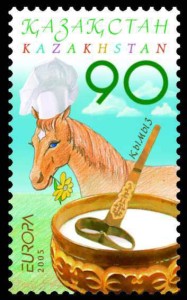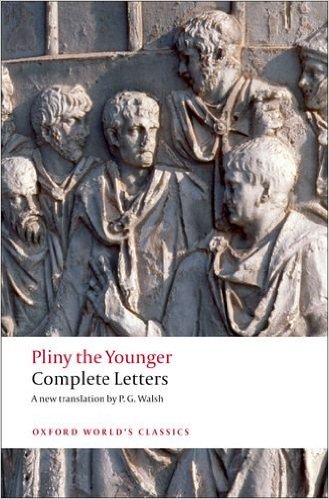
A Kazakhstani stamp depicting the fermented mare’s milk drink kumis that Herodotus wrote about in The Histories.
The Scythians were regarded by ancient Greek historians as a nation of tribal nomads inhabiting the north shore region of the Black Sea. Herodotus, who wrote extensively on the Scythian people, records how they considered themselves to be the youngest of all nations and were ruled by the kings of a wealthy clan called the Royal Scyths; they worshiped a hearth goddess as their chief deity that the Greeks identified with Hestia, practiced divination by means of a willow stick oracle, fought on horseback with bows and arrows, systematically blinded and enslaved their prisoners of war, and were fond of taking ritual cannabis steam baths. On top of all that we are told that they drank undiluted wine, the blood of slain enemies, and fermented mare’s milk (see footnote 1). The making of the latter of these traditional Scythian beverages, which goes by the name of kumis nowadays, is my subject in this post.
Kumis is an ancient beverage. It is thought to date back to the Botai culture of late 5th millennium BC Kazakhstan, and has remained important to the peoples of the Central Asian steppes up to the present day. I have tried a Mongolian variety of the drink before and consider it not delicious (see footnote 2).
Herodotus took an unusual interest in kumis production among the Scythians. It is fortunate for contemporary readers that he did. I say this mainly because the method of production he describes is very odd. According to John Marincola’s revised edition of the classic de Sélincourt translation [1], the process went as follows:
“They (the Scythians) insert a tube made of bone and shaped like a flute into the mare’s anus, and blow; and while one blows, another milks […] They make the blind men (the slaves) stand around in a circle, and then pour the milk into wooden casks and stir it; the part which rises to the top is skimmed off, and considered the best; what remains is not supposed to be good.”
The attentive reader will be successively agitated by two questions: first, the purpose served by doing the ancient equivalent of taking a bicycle pump to a horses’ rear end; and second, the need for blind milk stirrers.
The Halicarnassian writes in anticipation of these queries that the Scythians stimulate the anus in the manner described to make the mare’s veins swell with air and force her udder to drop, and blind all prisoners they take as slaves out of necessity because they are nomads. But according to A. D. Godley, Herodotus meant that the slaves were blinded to prevent them from stealing the best of the milk [2].

A mare being milked in the modern fashion in Suusamyr, Kyrgyzstan; photograph by Firespeaker, distributed under a CC-BY-SA 3.0 license.
So much for our questions.
But let us nevertheless pursue the matter a little further. Looking to other classical sources, we find that mare’s milk consumption among the Scythians is corroborated by Homer [3], Aeschylus [4], and Strabo [5] without reference to any of the surprising procedural details relevant to our present purpose (see footnote 3). An independent account is, however, supplied by Hippocrates in his treatise On Generation [6]. The father of medicine writes that:
“They (the Scythians) pour it (mare’s milk) into wooden bowls and agitate it; when it is agitated, it becomes foamy and separates; and the fatty part, which they call butter, being light is separated and rises to the surface. The heavy and thick portion settles downwards: they separate it off and dry it, and when it is coagulated and dry, they call it mare’s-milk cheese (“hippake”). The whey of the milk remains in the middle.”
Hippocrates assumes a technical tone of the sort that one might expect from a physician. And while his account is interesting in its own right, it unfortunately offers no additional insights into either the mare milking procedure or the significance of the blind stirrers.
Curiously enough, however, in a translation of Herodotus by Godley [2] that I stumbled upon, we find that the bone tube is inserted not into the mare’s anus, but rather her genitals! Although I found that in different edition of the same translation he chose to use the more ambiguous, or possibly euphemistic, term ‘secret parts’ [7].
Professor Marincola explained to me in a private correspondence on the matter (both de Sélincourt and Godley are dead) that Herodotus employed the term ‘τά ἄρθρα’ which means ‘the parts fitted together’ and is sometimes used to mean ‘joints’. He went on to write that given the literal meaning is unlikely in the context of mare milking, translators have interpreted it to mean either the anus or the female genitals, adding that the latter interpretation is somewhat more likely. For what it’s worth, I would hazard to guess that the genitals is the more likely of the two possibilities on the ground that they are linked with the udder in the mare’s reproductive system.
This brings us to the blind slaves. Godley speculated that the entire story of the blind slaves probably arose from some Scythian name for slaves that was misunderstood by Herodotus’ Greek sources. I have yet to find any better suggestions.
To conclude: it would seem that certain knowledge of how to make kumis the Scythian way is not to be found in the historical record. We must therefore content ourselves with plausible speculation and the hope of future archaeological and anthropological discoveries.
Addendum (18 June 2015)
Professor Marincola has brought new information to my attention that essentially settles the matter as to whether the Scythians stimulated mare anuses or genitalia during milking. In short, there is persuasive anthropological evidence to support that Herodotus was writing of the genitals. Marincola informed me that the renown Herodotean scholar David Asheri [8] took it to mean the genitals on the ground that ‘sexual stimulation in milking is paralleled among the Kalmuk and the Jahut as well as among several African and Arab pastoral peoples, including the Dinka.’ And with that it would seem that we have gotten to the bottom things.
Footnotes
[1] King Cleomenes of Sparta is said to have gone mad after picking up the habit of drinking wine undiluted by water from the Scythians.
[2] It is probably an acquired taste.
[3] Homer writes of ‘the lordly Hippemolgi that drink the milk of mares’ that inhabited a land beyond the Thracians. Strabo explicitly identifies the Hippemolgi, or mare-milkers, with the Scythians in response to post-Homeric authors who criticised the poet for being ignorant of these people. He furthermore quotes from a lost work by Aeschylus in support of his view.
References
[1] Herodotus (2003). The Histories, translated by Aubrey de Sélincourt and revised with introduction and notes by John Marincola. Penguin Classics. Book IV, Chapter II.
[2] Herodotus (1921). The Histories, translated by Alfred Denis Godley. G. P. Putnam’s sons. Book IV, Chapter II. Read this passage at the Perseus Digital Library.
[3] Homer (1924). The Iliad, translated by Augustus Taber Murray. Loeb Classical Library. Volume II. Book XIII, Chapter IV, Section I. Read this passage at the Perseus Digital Library.
[4] Aeschylus (1926). Aeschylus II: Agamemnon, Libation-Bearers, Eumenides, Fragments, translated by Herbert Weir Smyth. Loeb Classical Library. Volume 146. Fragment 111. Read this fragment at Theoi Greek Mythology.
[5] Strabo (1854). The Geography of Strabo, translated by Hans Claude Hamilton, esq. and William Falconer. Henry G. Bohn. Book VII, Chapter III, Section VII. Read this passage at the Perseus Digital Library.
[6] Hippocrates (2012). Hippocrates IX: Generation, Nature of the Child, Diseases 4, Nature of Women and Barrenness, translated by Paul Potter. Loeb Classical Library. Volume 150. Diseases 4, Chapter XX.
[7] Herodotus (1921). The Persian Wars, Books III and IV, translated by Alfred Denis Godley. Loeb Classical Library. Book IV, Chapter II. Read this passage at the Digital Loeb Classical Library.
[8] David Asheri et al. (2007). A Commentary on Herodotus Books I-IV. Oxford University Press.


One cannot help but wonder if your experience with the Mongolian variety of kumis was soured because the horse was not stimulated properly and the milk was not blindly stirred.
I guess you never know… One this is for sure though: I won’t made the same mistake of not asking the next time I have the opportunity to try it.